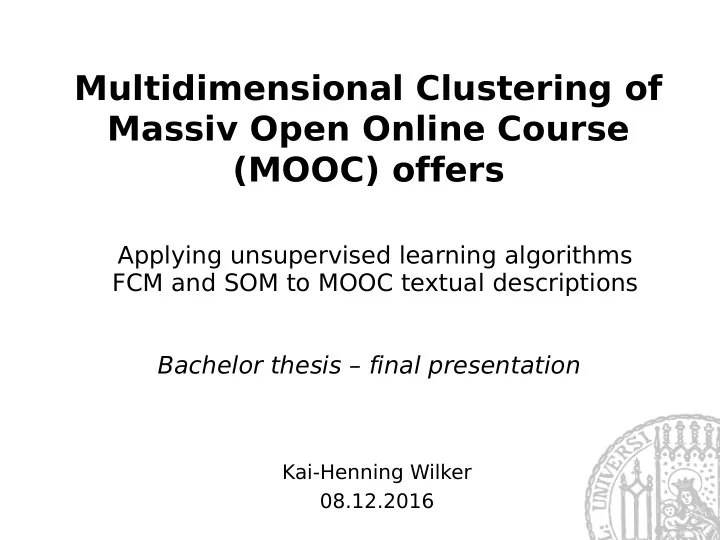

Multidimensional Clustering of Massiv Open Online Course (MOOC) offers Applying unsupervised learning algorithms FCM and SOM to MOOC textual descriptions Bachelor thesis – final presentation Kai-Henning Wilker 08.12.2016
Agenda Introduction / goals MOOC clustering application Clustering process Evaluation Conclusions & future work 2 08.12.2016
Goals Vision: build MOOC recommendation system for students Making recommendations using clusters Goal: cluster analysis of MOOC textual descriptions with Fuzzy C-Means (FCM) and Self-organizing Maps (SOM) Questions: Can valid clusters be found? Which clustering algorithm performs better? What are the best meta-parameters for the algorithms? What is the best vector representation of the documents? How to evaluate a cluster's quality? 3 08.12.2016
Agenda Introduction / goals MOOC clustering application Clustering process Evaluation Conclusions & future work 4 08.12.2016
System integration 5 08.12.2016
Cluster analysis process 6 08.12.2016
Agenda Introduction / goals MOOC clustering application Clustering process Evaluation Conclusions & future work 7 08.12.2016
Vector representation Consider the MOOC textual descriptions as „bag of words“ (→ each dimension represents one term) [~22,000 dimensions] Normalization by TF-IDF Reduce number of dimensions of the vectors with Latent Semantic Indexing (LSI) or Locality Preserving Indexing (LPI) [~10 dimensions] Insights: General term blacklist needs to be extended (e.g. filter terms like Illinois State University or capstone ) No clear winner between LSI and LPI 8 08.12.2016
Clustering algorithms Fuzzy C-Means (FCM) Derivative of k-Means using fuzzy sets Cluster centers are initialized randomly and are improved iteratively by calculating a weighted mean of each cluster Challenges with FCM Results of FCM highly depend on the initialization Solution: run FCM multiple times, return best result Even after dimension reduction: concentration of norm phenomenon Meta-parameters: c – Number of clusters m – „fuzzyness“ parameter 9 08.12.2016
Clustering algorithms Self-organizing Maps (SOM) SOM is a type of artifical neural network Map = two-dimensional grid of neurons Each neuron holds a weight vector that represents it's position in the input data vector space (→ with dimension higher than two!) Self-organization: Input vectors are propagated through the map For each vector, the nearest neuron is determined (the winning neuron) The weights of the winning neuron and the winning neuron's neighbours (on the map) are adjusted 10 08.12.2016
Clustering algorithms Insights on SOM SOM is less dependend on initialization than FCM SOM performs generally better than FCM Meta-parameters of SOM N x M – map dimensions (corresponds to number of clusters) α – initial learning parameter δ – initial neighbourhood radius 11 08.12.2016
Agenda Introduction / goals MOOC clustering application Clustering process Evaluation Conclusions & future work 12 08.12.2016
Internal Evaluation Internal evaluation: calculate „validity index“ using only the input vectors and the found clusters No external information is used The validity index computes a real number, which represents the quality of a clustering Aim of internal evaluation: tweak meta-parameters Method: compute clusterings for all values of the meta- parameter within a suitable range → the clustering with the best index value is selected → this determines the value of the meta-parameter Validity indices might be biased against one algorithm → one should not use internal validity indices to compare two clustering algorithms 13 08.12.2016
Internal evaluation: Validity Indices Defining „good“ clusters is to some extent subjective → There are many different validity indices available Validity indices measure the compactness and separation of clusters One exemplary index: Dunn index 14 08.12.2016
Exemplary results LPI reduction – how many dimensions? FCM with c=64, m=1.5 1,4 1,2 1 MPC 0,8 FS 0,6 0,4 0,2 0 0 5 10 15 20 25 30 35 Number of dimensions 15 08.12.2016
Exemplary results How many clusters? FCM with m=1.5 using 10-dimensional LPI vectors 0,9 0,8 0,7 0,6 MPC 0,5 FS 0,4 not helpful 0,3 0,2 0,1 0 10 20 30 40 50 60 70 80 90 100 Number of clusters 16 08.12.2016
External Evaluation Use additional, external information Create clusters manually as „golden standard“ (in the following, these clusters are called classes ) Compare clusterings with the manually created one Purity : Assign each cluster to the class, which is most frequent in the cluster Count the number of correctly assigned input vectors Downside: „Golden standard“ created by only one single person → very subjective This method is hardy applicable for fuzzy clustering 17 08.12.2016
Agenda Introduction / goals MOOC clustering application Clustering process Evaluation Conclusions & future work 18 08.12.2016
Conclusions SOM performed generally better than FCM on our data Even with small m , FCM was too fuzzy (e.g. one MOOC belongs to too many clusters) FCM has problems with vectors of higher dimension SOM worked better with vectors of higher dimension Internal evaluation has strong limits Evaluation indices sometimes contradict each other Which index is suitable? → hard to decide External evaluation needs more feedback by different users (→ see future work) 19 08.12.2016
Future Work Use more data (syllabus, category) Smarter initialization for FCM Other distance functions except Euclidean, different vector representations How do the clusters change over time? Utilize user feedback: Create ranking within each cluster Semi-supervised clustering: improve clusters using the user feedback Use the feedback for external evaluation 20 08.12.2016
SOM – Further Details (Image source: Wikipedia) 21 08.12.2016
SOM – Further Details 22 08.12.2016
Recommend
More recommend